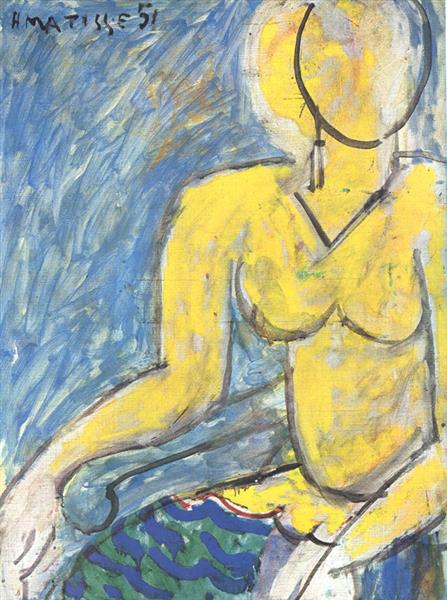Description
"Kathy With a Yellow Dress" from 1951 is a work that sublimely captures the essence of Henri Matisse's late style, an undisputed master of color and form. In this painting, Matisse presents us with a composition that at first glance may seem simple, but which, as is characteristic of his works, reveals notable depth and sophistication.
The protagonist of the work, Kathy, is immortalized in a yellow dress that dominates the composition. This color, which Matisse uses here with remarkable mastery, is not a mere complement; it is the vibrant core of the work. The yellow, warm and bright, suggests not only Kathy's youth and vitality but also the light and optimism that Matisse sought to convey in his works of this era.
The black and white background strongly contrasts with Kathy's dress and skin, creating a visual tension that naturally directs the viewer's gaze toward the central figure. Matisse, with his typical skill, uses these contrasts to highlight the figure and add a sense of depth and three-dimensionality to a work that, at first glance, remains two-dimensional.
Kathy's posture, seated with her arms relaxedly crossed on her lap, suggests a stillness and serenity that contrasts with the dynamism of the color surrounding her. The fluid and confident strokes that outline her contours are revealing of the artist's mature period, who in these last years of his life had turned to the technique of cutouts and the use of pure color.
The portrait also reflects a disturbing simplicity in Kathy's facial expression, almost enigmatic, adding an additional layer of introspection to the work. This technique, which plays with the abstract and the figurative, is emblematic of Matisse's period known as "cut-out" or "gouaches découpés", where the artist explored the synthesis of form and color through the technique of cutting painted paper.
Henri Matisse (1869-1954) was one of the most innovative and original artists of the 20th century, known for his bold and radical explorations of color and form. His influence on modern art is undeniable, and his later style, epitomized in works like "Kathy With a Yellow Dress", continues to be a source of study and admiration.
This work is set in a historical context where Matisse, having already suffered health problems that impaired his ability to work on traditional canvases, found in scissors and paper a means to continue exploring his obsession with form and color. This innovative technique of papiers découpés, which he perfected towards the end of his life, allowed Matisse to turn physical limitations into a new form of creative expression.
"Kathy With a Yellow Dress" is not only a testament to Henri Matisse's technical mastery and aesthetic sensitivity but also to his unbreakable creative spirit. The painting thus stands not only as a work of art in itself but also as a symbol of resilience and constant renewal, values that Matisse carried throughout his life and that continue to inspire new generations of artists and art lovers.

